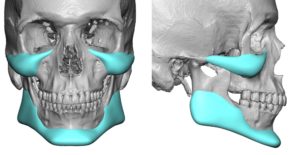
As custom facial implants are becoming more popular due to improved technology, there are numerous misconceptions about them. Here are some things you may not know about custom designed and fabricated facial implants.
Custom Facial Implants Are Not Really New. While the technology has dramatically improved and the internet has made their existence easily found, the use of custom implants for the face has historic precedence. Surgeons for years have used blocks of various materials to fashion implants during surgery. (although I would call this a semi-custom approach with a lot of guesswork in doing so) But the use of a patient’s model to create an exact fitting implant to the bone before surgery dates back to when higher resolution CT scanning and computer-generated models became available. I did my first such custom facial implant case back in 1997 where modeling clay was used to create a mockup of the implant from a resin-spun hand-held model.
A 3D CT Scan Is Needed To Make Custom Implants. Whether it is done by an actual model or on the computer screen, only a high resolution CT scan of the face with 3D reconstruction can be used. The scan has to be done using .1mm slices and not the standard 3mm or 1mm slices normally taken. An old or regular facial CT scan will not do nor will an MRI. These type of facial CT studies are quick and easy to do today at a very low cost at any CT scanning facility. The software to do them is now standard.
The Design May Be Done On The Computer But The Surgeon Creates It. While computers and their software can do incredible things, they do not yet know how to create a specific look for any patient. In designing facial implants, the computer has no innate knowledge or software algorithms to know what size or shape the implant(s) needs to be….unless they have a desired and exact target to mirror. This works for facial asymmetry (making an implant to match an opposite normal side) but not for purely aesthetic facial augmentations. It is the doctor that must tell the computer (specifically the design engineer) the shape, thickness and orientation that they want the implants to be. The computer design process will make sure the implants fit the bone perfectly and compensate for any bony asymmetries.
Custom Implants Can Be Made For Any Craniofacial Area. Implants can be designed from the end of the jaw to the back of the skull on any bone area. While most implants are made for bone augmentation, soft tissue implants can be similarly made. The outline and bulk of the muscles on the bone can be imaged and implants designed to fit under or on top of them. This is most useful for the temporal region where aesthetic width issues may exist.
The Cost of Custom Facial Implants Can Be Affordable. While the cost of custom implants does cost more than using preformed implants, the difference today is not as dramatic as it once was. If one has significant facial asymmetry or has extreme facial augmentation needs, the use of preformed implants may lead to disappointing results and revisional surgery. This can end up costing much more than using custom implants initially.
Dr. Barry Eppley
Indianapolis, Indiana


